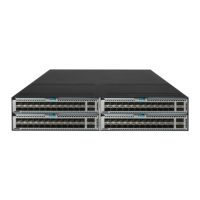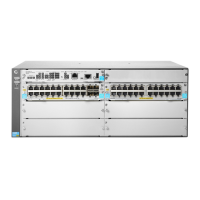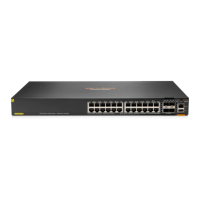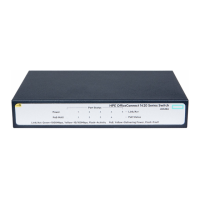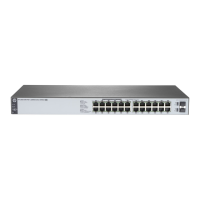62
This task excludes the traffic in the specified VLANs from the load sharing mechanism on the
aggregate link.
An aggregation group can have only one management port. If you specify multiple ports in an
aggregation group as management ports, the system chooses the port with the lowest port number
as the management port.
To forward the traffic in specific VLANs out of a fixed port on an aggregate link:
Step Command Remarks
1. Enter system view.
system-view
N/A
2. Specify the management
VLANs.
link-aggregation
management-vlan
vlan-id-list
By default, no management
VLANs exist on aggregate links.
You cannot specify VLAN 1 as a
management VLAN.
3. Enter Layer 2 Ethernet
interface view.
interface
interface-type
interface-number
If the Layer 2 Ethernet interface is
not an aggregation member port,
the management port setting
takes effect after the interface is
assigned to an aggregation group.
4. Configure the interface as a
management port.
link-aggregation
management-port
By default, an interface does not
act as a management port in its
aggregation group.
Excluding a subnet from load sharing on
aggregate links
IMPORTANT:
This feature is available in 2510P01 and later.
Typically, an aggregate interface distributes traffic across its Selected member ports. The uplink and
downlink traffic of a host might be distributed to different member ports, as shown in Figure 12. T
o
make sure the bidirectional traffic of a subnet traverses the same member port, you can exclude that
subnet from load sharing by specifying it as a link aggregation management subnet.
When an aggregate interface receives an ARP packet from the management subnet, the device
looks up the sender IP address in the ARP table for a matching entry.
• If no matching entry exists, the device creates an ARP entry on the aggregation member port
from which the packet came in. This mechanism ensures that the returned downlink traffic will
be forwarded out of the member port that received the uplink traffic.
• If an ARP entry already exists on a different port than the aggregate interface or its member
ports, the device does not update that ARP entry. Instead, the device broadcasts an ARP
request out of all ports to relearn the ARP entry.
When an aggregate interface sends an ARP packet to the management subnet, the device sends
the packet out of all Selected member ports of the aggregate interface.
As shown in Figure 12,
an aggregate link is established between the server and the IRF fabric. The
server sends all uplink traffic of a subnet through Port C1 to Port A1 on the IRF fabric. If that subnet
is not specified as a management subnet, the IRF fabric distributes its downlink traffic across Port A1
and Port B2. To send the downlink traffic of that subnet to the server only through Port A1, you can
specify the subnet as a link aggregation management subnet.

